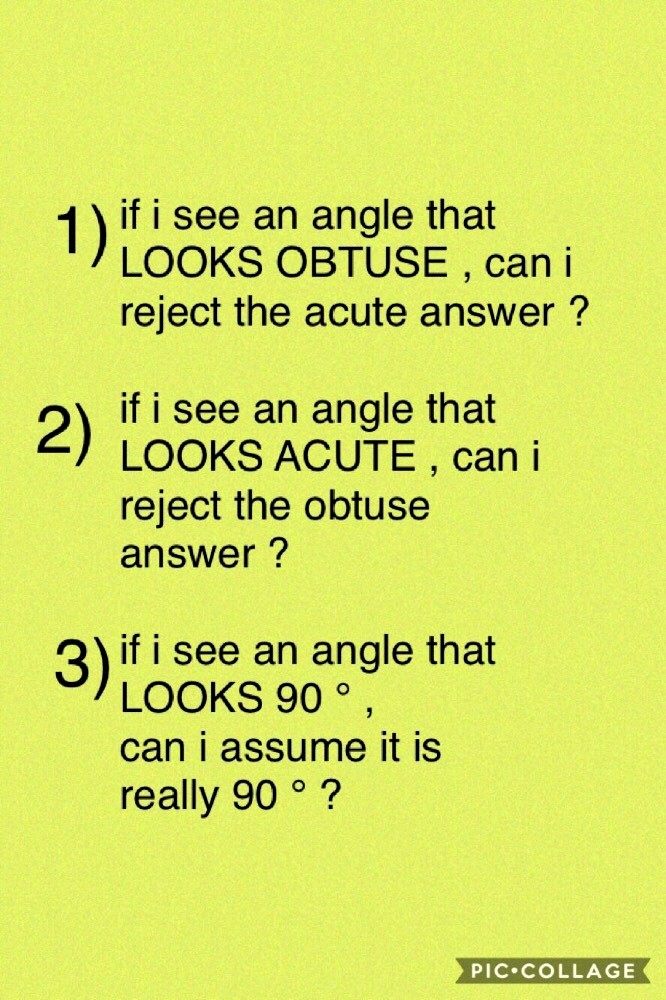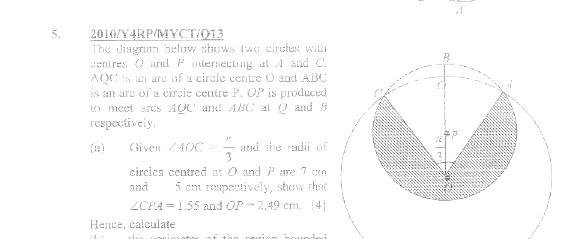Ask Singapore Homework?
Upload a photo of a Singapore homework and someone will email you the solution for free.

Question
secondary 3 | E Maths
One Answer Below
Anyone can contribute an answer, even non-tutors.

pls help thanks
See 1 Answer
Angle CPQ (or APQ) = sin-¹(3.5/5)
And that you've also applied the converse of the property ' the perpendicular bisector of a chord passes through the centre'
Now realise that triangle CPQ and APQ are right angled triangles (because angle CQP and AQP are 90° as deduced from the property above)
Since the angle sum of a triangle is 180°,
then angle CPQ + angle QCP
= 180° - angle CQP
= 180° - 90°
= 90°
(Likewise for angle APQ)
So, angle CPQ and angle APQ must be < 90° for the above equality to hold true
(we don't have negative angles in triangles and the two non-right angles in a right angled triangle are always acute)
Therefore, even though sin-¹(3.5/5) could be ≈ 0.775396 rad (44.42700°) or ≈ 2.366195 rad (135.57299°), we reject the obtuse angle since we have already deduced that angle CPQ and angle APQ are acute.
It follows that angle CPA
= 2 x angle CPQ or 2 x angle APQ
≈ 2 x 0.775396 rad
= 1.550792 rad
= 1.55 rad (3 s.f)
besides R formula , is there another method ?
https://en.m.wikipedia.org/wiki/Tangent_half-angle_substitution#The_substitution
3sinx + 4cosx = 2
So 3sinx = 2 - 4cosx
Square both sides,
9sin²x = 4 - 16cosx + 16cos²x
9 - 9cos²x = 4 - 16cosx + 16cos²x
25cos²x - 16cosx - 5 = 0
Using quadratic formula,
cosx = 8/25 ± 3√21 /25
x = cos-¹(8/25 + 3√21 /25)
or x = cos-¹(8/25 - 3√21 /25)
x ≈ 29.55(rej), 330.45°, 389.55°(rej), 690.45°,...
or
x ≈ 103.31,° 256.69°(rej), 463.31°, 616.69°(rej),...
Note that we squared the expression at first. So not all values of x found will satisfy the initial equation
3sinx + 4cosx is positive (>0)
When cosx is negative, x is in the 2nd or 3rd quadrant. But when the x is in the 3rd quadrant, both cosx and sinx are negative.
So this would result in a negative value of 3sinx + 4cosx . So all 3rd quadrant values of x are rejected.
For the rest, you'll have to check and see whether the 1st, 2nd and 4th quadrant values satisfy the equation.





